From drawings to puppet shows: practical ways in teaching vocabulary to primary school EFL learners
DOI:
https://doi.org/10.28918/erudita.v2i1.5328Keywords:
Games for learning, Puppet shows, Young EFL learners, Teaching vocabularyAbstract
Mastering vocabulary is one of fundamental conditions that determine learners’ success to be skilled in learning English. The present study aims to explore how young EFL learners engage in learning vocabulary through puppet shows. Grounded in a qualitative approach, this study employed classroom action research (CAR) consisting of two cycles. 11-12 years-old sixth graders of an Islamic primary school in Pekalongan, Central Java, Indonesia volunteered to take part in this study. Data were collected through classroom observation, written documents, and interviews. The data were analyzed by reducing data, displaying data, and verifying conclusion. Findings of the study show that the young EFL learners were more enthusiastic about learning English and participating in vocabulary activities. The learners were encouraged to actively respond to the question and provide meaningful feedback. By supplying the EFL learners with engaging puppet shows, the researchers set fascinating activities for them to guarantee that they were not bored in class. Many vocabularies had already been introduced to the students when the study was overtaken. This study contributes to empirical insights into how puppet shows are adopted in teaching vocabularies to primary school EFL learners that has shifted from drawings as educational media.
References
Aranguren-Gassis, M. (2017). Using puppet shows to educate children about plastic waste problem in the ocean (PEPO Project). Limnology and Oceanography Bulletin, 26(3), 75-77. https://doi.org/10.1002/lob.10196
Astriyanti, D., & Anwar, K. (2016). Improving students’ ability in vocabulary mastery through index card match. Edukasi: Jurnal Pendidikan, 14(1), 40-52. https://doi.org/10.31571/edukasi.v14i1.284
Banfield, J. (2020). ‘That’s the way to do it!’: Establishing the peculiar geographies of puppetry. Cultural Geographies, 28(1), 141-156. https://doi.org/10.1177%2F1474474020956255
Caganaga, C., & Kalmis, A. (2015). The role of puppets in kindergarten education in Cyprus. Open Access Library Journal, 2, 1–9. https://dx.doi.org/10.4236/oalib.1101647
Chou, M. (2014). Assessing English vocabulary and enhancing young English as a Foreign Language (EFL) learners’ motivation through games, songs, and stories. Education 3-13, 42(3), 284-297. https://doi.org/10.1080/03004279.2012.680899
Coyne, I., Mallon, D., & Chubb, E. (2021). Research with young children: Exploring the methodological advantages and challenges of using hand puppets and draw and tell. Children & Society, 35(5), 813-830. https://doi.org/10.1111/chso.12452
Dunst, C. J. (2014). Meta-analysis of the effects of puppet shows on attitudes toward and knowledge of individuals with disabilities. Exceptional Children, 80(2), 136-148. https://doi.org/10.1177%2F001440291408000201
Egusa, R., Sakai, T., Tamaki, H., Kusunoki, F., Namatame, M., Mizoguchi, H., & Inagaki, S. (2016). Designing a collaborative interaction experience for a puppet show system for hearing-impaired children. In K. Miesenberger, C. Bühler, & P. Penaz (Eds.), Computers Helping People with Special Needs: Lecture Notes in Computer Science of International Conference on Computers Helping People with Special Needs (ICCHP) 2016 (pp. 424–432). Springer, Cham. https://doi.org/10.1007/978-3-319-41267-2_60
Elmahida, H., Nia, D. P., & Komariyah, T. (2021). Exploring teachers' strategies in teaching writing for young learners. Erudita: Journal of English Language Teaching, 1(1), 65-75. https://doi.org/10.28918/erudita.v1i1.4274
Escobar-Chaves, S. L., Shegog, R., Markham, C., & Brehm, B. J. (2010). “The McSpoons”: Using puppetry’s narrative impact to reduce family TV time. Arts & Health, 2(1), 47-66. https://doi.org/10.1080/17533010903031416
Guilherme, M. (2007). English as a global language and education for cosmopolitan citizenship. Language and Intercultural Communication, 7(1), 72-90. https://doi.org/10.2167/laic184.0
Harmer, J. (2007). The practice of English language teaching. Pearson Longman.
Hornby, A. S. (2000). Oxford advanced learners dictionary. Oxford University Press.
Huyen, N. T. T., & Nga, K. T. T. (2013). Learning vocabulary through games: The effectiveness of learning vocabulary through games. The Asian EFL Journal, 1-15. http://www.asian-efl- journal.com/dec_03_sub.Vn.php
Jones, S. M., Zaslow, M., Darling-churchill, K. E., & Halle, T. G. (2016). Assessing early childhood social and emotional development: Key conceptual and measurement issues. Journal of Applied Developmental Psychology, 45, 42-48. https://doi.org/10.1016/j.appdev.2016.02.008
Karolis, O. (2020). Inclusion happens with a puppet: Puppets for inclusive practice in early childhood settings. NJ: Drama Australia Journal, 44(1), 29-42. https://doi.org/10.1080/14452294.2020.1871506
Kemmis, S., & McTaggart, R. (1988). The action research planner (3rd ed.). Deakin University Press.
Kemmis, S., McTaggart, R., & Nixon, R. (2014). The action research planner: Doing critical participatory action research. Springer.
Lin, C-C., Hou, G-C., & Li, T-Y. (2010). Motion generation for glove puppet show with procedural animation. In F. Huang, & R. C. Wang (Eds.) Arts and Technology: Lecture Notes of the Institute for Computer Sciences, Social Informatics and Telecommunications Engineering ArtsIT 2009 (pp. 247-254). Springer. https://doi.org/10.1007/978-3-642-11577-6_31
Merriam, S. B., & Clark, M. C. (1991). Lifelines: Patterns of work, love, and learning in adulthood. San Francisco.
Ozdeniz, D. (2000). Puppets in primary. Longman.
Packer, M. J., & Moreno-Dulcey, F. A. (2022). Theory of puppets? A critique of the use of puppets as stimulus materials in psychological research with young children. Cognitive Development, 61, 1-21. https://doi.org/10.1016/j.cogdev.2021.101146
Pitre, N., Stewart, S., Adams, S., Bedard, T., & Landry, S. (2009). The use of puppets with elementary school children in reducing stigmatizing attitudes towards mental illness. Journal of Mental Health, 16(3), 415-429. https://doi.org/10.1080/09638230701299160
Puspitasari, D., Maulida, C., & Noviyanto, N. (2019). “Say no bad touch”: The use of puppet show to promote children’s awareness of their private parts. Muwazah: Jurnal Kajian Gender, 11(2), 263-278. https://doi.org/10.28918/muwazah.v11i2.2274
Remer, R., & Tzuriel, D. (2015). “I teach better with the puppet” – Use of puppet as a mediating tool in kindergarten education – an evaluation. American Journal of Educational Research, 3(3), 356–365. http://dx.doi.org/10.12691/education-3-3-15
Riyani, I. (2019). Utilizing storytelling technique using finger puppet in teaching vocabulary mastery to young learner. Jurnal JOEPALLT (Journal of English Pedagogy, Linguistics, Literature, and Teaching), 7(1), 1-14. https://doi.org/10.35194/jj.v7i1.539
Romanski, N. M. (2019). Reigniting the transformative power of puppets through narrative pedagogy, contemporary art, and transdisciplinary approaches in art education. Art Education, 72(4), 36-42. https://doi.org/10.1080/00043125.2019.1602496
Ronfard, S., & Corriveau, K. H. (2016). Teaching and preschoolers’ ability to infer knowledge from mistakes. Journal of Experimental Child Psychology, 150(October), 87-98. https://doi.org/10.1016/j.jecp.2016.05.006
Saleh, A. M., & Althaqafi, A. S. A. (2022). The effect of using educational games as a tool in teaching English vocabulary to arab young children: A quasi-experimental study in a kindergarten school in Saudi Arabia. SAGE Open, 12(1), 1-10. https://doi.org/10.1177%2F21582440221079806
Schmidt, M. F., Hardecker, S., & Tomasello, M. (2016). Preschoolers understand the normativity of cooperatively structured competition. Journal of Experimental Child Psychology, 143(March), 34-47. https://doi.org/10.1016/j.jecp.2015.10.014
Sugiyono. (2015). Metode penelitian pendidikan pendekatan kualitatif,
kuantitatif, dan R&D [Qualitative, quantitative, and R&D research methods in education]. Alfabeta.
Suzan, O. K., Sahin, O. O., & Baran, O. (2020). Effect of puppet show on children’s anxiety and pain levels during the circumcision operation: A randomized controlled trial. Journal of Pediatric Urology, 16(4),1-8. https://doi.org/10.1016/j.jpurol.2020.06.016
Thornbury, S. (2002). How to teach vocabulary mindmap. Bluestone Press.
Yolanda, D., & Hadi, M. S. (2019). Using puppet games in teaching speaking for tenth graders of senior high school. English Language in Focus (ELIF), 2(1), 1-8. https://doi.org/10.24853/elif.2.1.1-8
Victoria, B. (2008). Oxford learner’s pocket dictionary. Oxford University Press.
Downloads
Published
How to Cite
Issue
Section
License
Copyright (c) 2022 Rizki Maulida Khasanah, Ali Burhan

This work is licensed under a Creative Commons Attribution-ShareAlike 4.0 International License.















